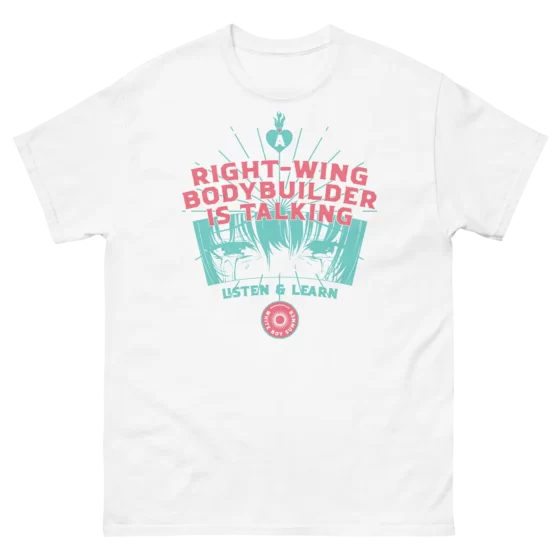What BAP Didn’t Learn from Feminism
There’s absolutely no reason why you should be paying attention to what goes on over at Compact Magazine. Because removepaywall.com doesn’t work for the Compact site, you have to pay $90 a year to read shitty articles about “gnostic bodybuilders” by Malcolm Kyeyune – aka “Tinkzorg” – or pieces asking important questions like “Are chemicals causing gender chaos?” that have been cribbed, almost word for word, from articles I’ve written. There aren’t enough ideas to go round at Compact it seems, not real ones the writers can call their own, so they either invent absurd caricatures, like the aforementioned “gnostic bodybuilders,” or they just nick other people’s work, then hide all but the first few sentences behind a paywall to make you think there’s something worth reading back there. $90 a year, by the way.
A few months ago, the man who copied my work on endocrine disruptors, Geoff Shullenberger, wrote a piece about the anonymous figure Bronze Age Pervert (BAP), and the man he thinks is Bronze Age Pervert, Costin Alamariu, who’d just written a new book that’s been very popular indeed. “What BAP learned from feminism,” the piece is called. File this one under “absurd caricature.” It’s certainly not friendly. Then again, there are plenty of pieces about BAP these days and most of them are unfriendly; although a few are actually quite warm. It’s hard not to like BAP, especially if you’ve actually read Bronze Age Mindset.
So, there’s something of a cottage industry these days with dozens of largely unsuccessful writers churning out a steady stream of pieces about anonymous figures on the online right, mainly BAP but also me and a few of my other friends. There must be some degree of coordination behind the scenes, since new talking-points and speculations emerge in multiple places at once. Maybe there’s a Slack channel or Whatsapp group these dorks are in, with some minor functionary of the regime feeding them the latest plan of attack against the right-wing bodybuilders and their spiritual leader, the BAPman. I wouldn’t bet against it. Something like that is definitely happening with the Keith Woods types and the Fuentard / closet-homosexual Latinx tradcaths on Twitter – you know, the ones who think BAP has a “Talmudic network” and post “Aren’t you a Jew?” under every tweet written by suspected members of this shady organisation, including myself.
One tack that’s been tried a number of times is to connect BAP to real-world violence, to dangerous individuals who’ve done pointless destructive things, like the moron Lyndon McLeod, a.k.a. “Roman McClay,” who shot up a tattoo parlour and a killed a bunch of tattooed people he didn’t like – he had a tattoo parlour himself and lots of tattoos – before being blown away by Denver PD. McLeod actually wrote a book himself called Sanction, a “novel” in which the protagonist, er… Lyndon McLeod, murders the author Lyndon McLeod’s future victims. Talk about meta! Commentary on the rampage, and McLeod’s Wikipedia page, tells us loudly that he was a fan of BAP’s Twitter account and read Bronze Age Mindset, but he clearly didn’t learn a single thing from the book, which says nothing about being a schizophrenic loser and murdering your business competitors over a bunch of small perceived slights. Or did I miss that part?
BAP also featured alongside me in a bizarre paper by the “Global Network on Extremism and Technology,” a Zuckerberg-funded think tank, about the “far right” and its “obsession with raw food.” Apparently, by encouraging people to eat raw milk and raw eggs and avoid exposure to estrogenic chemicals, we’re somehow also encouraging them to seek violent overthrow of the government. There’s no way to make this conclusion sound less ridiculous than it actually is, but two university academics were paid to research and write the piece, so somebody with clout and a bit of cash obviously thought it was worth a squirt.
Really, this is what I think is going on: the aim is to get enough media outlets and think tanks and talking-heads to say that BAP and other figures on the online right are violent extremists or “domestic terrorists,” and then the authorities will have cause to treat them as such. Simple. Maybe it will work. I hope not.
Anyway, back to Geoff Shullenberger. His big “gotcha” for BAP and Costin Alamariu is that they – he – is actually just a kind of inverted liberal, a shade of liberalism if you will, because he repeats a “myth of matriarchal prehistory” that is of great importance to certain varieties of modern feminism, especially the so-called “goddess” movement. The myth is, briefly, that there was an old Europe, many thousands of years ago, that was broadly egalitarian and peaceful, and where women were afforded the highest status, even worshipped in the form of fertility deities. This suddenly changed, however, with the arrival of nomadic pastoralists from the steppe – the Indo-Europeans – who subjugated the women-loving people and imposed a new hierarchical, patriarchal order, setting the stage for the rest of world history in its hierarchical, patriarchal form. This myth found its fullest exposition in the later work of the Lithuanian archaeologist Marija Gimbutas, who died in 1994. And it is a myth, at least as far as there’s no evidence a truly matriarchal society has ever existed, in Europe or anywhere else. On that point, all serious anthropologists, archaeologists and historians concur. But the Indo-Europeans existed, and they certainly shook things up with their arrival in Europe, as we’ll see.
One thing that’s worth adding about the “matriarchal myth of prehistory,” before we go any further, is its importance to leftism across the board, and not just some kinds of feminism. A belief in the actual existence of matriarchy in the past is foundational to modern leftism, all the way back to the early days of Marxism. The matriarchal conception of history became formally integrated into Marxist dialectical materialism with the publication, in 1884, of Friedrich Engels’ The Origin of the Family, Private Property and the State. The Origin traces the emergence of class society out of a so-called “primitive matriarchy.” On Engels’ reading of history, the emergence of class society was not just the overthrow of the egalitarian ideal, but also the beginning of the overthrow and ruin of women as a sex. Class society is, by its nature, patriarchal, since it depends on the man’s control over the reproductive function of the woman. This is where monogamy and then private property, and later the state, emerge from.
I called this tradition “the Longhouse Delusion” in a piece I wrote for MAN’S WORLD Issue Ten. The Longhouse Delusion tells us as much about the value of the dominant leftist conception of history as it does about the fundamental misunderstanding of human nature and society at the heart of modern leftism in all its forms. “What we know and feel intuitively — that leftism is a monstrous falsification of the human spirit and history — is true,” I wrote.
“The leftist egalitarian vision of a world free from hierarchy is rooted in fantasy and inversion, plain and simple. On the intellectual plane, we already know this from Nietzsche and The Genealogy of Morals, and an examination of primitive matriarchy and longhouse values – the root of the Marxist theory of historical materialism – only confirms this further.”
It’s easy to see why this claim about BAP’s “feminism” would be of great value not just to Shullenberger but also to the wider “post-liberal” crowd, including fellow Compact contributors like Sohrab Ahmari, who joyously promoted the article on Twitter when it was published. Basically, if the claim is true, it means this incredibly popular new movement on the right is nothing more than a product or epiphenomenon of liberalism. And therefore, like liberalism, BAPism can be dismissed totally out of hand: that’s what the “post” in “post-liberal” means. BAPism is a symptom, not the solution.
What’s also easy to see is that Geoff Shullenberger hasn’t read Costin Alamariu’s new book very carefully, if he’s even read it at all. There’s a certain amount of confusion involved in discerning exactly what Costin Alamariu or BAP thinks, since a) it remains to be proven that they’re the same person; b) even if the two men are one and the same, the thesis upon which Costin Alamariu’s book is based is at least three years older than Bronze Age Mindset, and there’s no reason to believe the two books should be totally consonant with each other; and c) many of BAP’s ideas have been elaborated or popularised by others in ways that seem contrary to their creator’s original purpose, not least of all the idea of “the longhouse,” which is most germane to Shullenberger’s critique. Longhouses were the dwellings of the neolithic inhabitants of Europe before the arrival of the steppe nomads, and with the idea of “the longhouse” they serve as a synecdoche for the stifling, feminised way of life of their inhabitants, which isn’t too different from the stifling, feminised way of life today in the modern world… For the purposes of this essay, let’s just assume that Costin Alamariu is BAP.
Now if you actually read Selective Breeding and the Birth of Philosophy, you’ll see that Costin Alamariu in no way endorses the “myth of matriarchal prehistory.” Despite an extensive bibliography, he doesn’t cite the work of Marija Gimbutas or even gesture towards it. Don’t get me wrong: there are definite similarities between what Gimbutas had to say about Europe in the late Neolithic and Alamariu’s theory about the “prephilosophical political life” and its overthrow, but these similarities are in exactly the places where the work of Gimbutas cleaves most to the actual evidence. Although her later work is a mess of hippy-trippy wish fulfilment, the product of her deepening involvement with radical feminists in California, that interpretation was nevertheless built on her hugely influential “Kurgan hypothesis” about the steppe origin of the ancient Indo-Europeans, which has been stunningly vindicated by recent advances in ancient DNA studies by people like David Reich at Harvard. So while both Alamariu and Gimbutas agree on the basic idea that a qualitative change was introduced to ancient European life by invaders of steppe ancestry, nowhere in Selective Breeding is there mention of matriarchy, of rule by women, or of worship centring on female goddesses. Not once.
BAP, by contrast, does point toward the work of Gimbutas in Bronze Age Mindset, in at least four separate places. On the whole, these gestures are mostly rhetorical flourishes, in keeping with the general polemical tone of the book. For example, on page 192 of Bronze Age Mindset, we read the following:
“I’m sure that Europe prior to the Bronze Age, before the coming of the Aryans, was similar to modern Europe. People lived in communal longhouses and were likely browbeaten and ruled by obese mammies who instilled in them socialism and feminism.
“Most of those so-called males of the longhouse age were probably similar to the modern leftist ‘herb’ who doesn’t lift. Which is why those societies were so easily conquered.”
This does, indeed, sound like Gimbutas, apart from the negative portrayal of life back then. But there’s obviously a certain licence at work here, because much earlier in the book, on page 62, BAP has already given us a more detailed sense of what pre-Bronze Age Europe was actually like.
“If you want to see our future as it existed before 1600 BC, or much of the world as it was until recently and still is… the communal life of the longhouse with its young men dominated and broken by the old and sclerotic, by the matriarchs, the blob and yeast mode in human life overtaking and subjecting all higher aspiration.”
It’s not just women who dominate now, but “the old and sclerotic” as well, with the effect of “subjecting all higher aspiration”. Here, then, we have a clear nod to the notion of a “gyno-gerontocratic democracy” as elaborated in detail in Selective Breeding and the Birth of Philosophy. But this isn’t the “matriarchal myth of prehistory:” it’s something else. A quotation from pages 29 to 30 Selective Breeding tells us precisely what:
“…primitive tribal life can be characterized as a fundamental democracy or more accurately a gyno-gerontocratic democracy, a fundamental democracy that is administered by elders and councils of elders… it is ruled by ancestral custom or nomos, in an absolute and “totalitarian” way, ruled by tribal conventions, laws and myths that regulate almost every aspect of life, allow no individual distinction, and ruthlessly quash any form of intellectual questioning or dissent.”
The argument of Selective Breeding, which Bronze Age Mindset echoes, is that a fundamental break occurred in European history, socially and politically, as a result of conquests by outside groups, which came to form new aristocracies. This new social and political order, built on a conception of “nature” rooted in biological hierarchy, would in turn give birth, in ancient Greece, to the figure of the philosopher and the philosophical school, which was modelled on the koryos, comitatus or ancient warband.
Alamariu follows J.G. Frazer in arguing that ancient tribal life was, above all, a kind of “totalitarian democracy” governed by nomos or custom, broadly speaking, and its guardians were the elders of the tribe. The power of nomos, the hold of tradition on the thoughts and actions of tribal people, was so great that, despite internal efforts by powerful magic men who might create short-lived forms of kingship for themselves, it could only be broken properly through outside force.
In many if not most cases, the rule of nomos was overthrown when pastoralists conquered a settled agricultural population. If Selective Breeding is anything, it’s an argument about aristocracy-formation and, in particular, its almost inevitable basis in racial difference. Pastoralists have an intimate knowledge of stock-breeding and it seems only natural that their insights about animal heredity should have been extended to people as well, in a way that made the pastoralists, quite literally, a breed apart from settled agriculturalists. This link between stock-breeding and human hierarchy is one that we encounter repeatedly through the long history of Eurasia, well into the Middle Ages. I love the following passage from Jack Weatherford’s book about Genghis Khan:
“For the Mongols, the lifestyle of the peasant seemed incomprehensible. The Jurched [i.e. non-Mongol] territory was filled with so many people and yet so few animals; this was a stark contrast to Mongolia, where there were normally five to ten animals for each human. To the Mongols, the farmers’ fields were just grasslands, as were the gardens, and the peasants were like grazing animals rather than real humans who ate meat. The Mongols referred to these grass-eating people with the same terminology that they used for cows and goats. The masses of peasants were just so many herds, and when the soldiers went out to round up their people or to drive them away, they did so with the same terminology, precision, and emotion used in rounding up yaks.”
It’s immediately noticeable that Alamariu draws his examples of racial aristocracies from the length and breadth of Eurasia and even Africa, down to the present-day Hutu and Tutsi of Rwanda, whose physical differences were great enough to fuel a civil war of unspeakable cruelty, within living memory. This racial model may very well be a universal explanation of how aristocracies come into being, or something close to it.
The relationship between agricultural and pastoral societies; the nature of thought and its relationship to primitive forms of social organisation; the emergence of aristocracy and the changes it brings to thought and social organisation – these are all matters for empirical investigation in Selective Breeding, and Alamariu’s claims about them are well substantiated, both in the material he cites and in material he doesn’t.
Much of what Alamariu says, as I noted just a moment ago, has a far wider importance than the Bronze Age. The clash between gyno-gerontocratic democracy and a higher form of life, as embodied in a mobile pastoral life, is beautifully illustrated, for example, in Montaillou, the famous social history of a village in medieval France. There, in the foothills of the Pyrenees, the historian Emanuel Le Roy Ladurie gives us a window into an intimate hell of village life, where the principal concern is to ensure the proper descent of the household and its resources, even to the extent that inbreeding was considered preferable to keep property within the family; where a form of ancestor worship not unlike the Chinese system prevailed, with the dead having to be constantly appeased by the living to ensure good fortune; where women wielded a variety of crushing powers in the domestic sphere and a significant proportion of official testimony to the church consisted of men insulting their wives and mistresses; where petty conflict within and among households was endemic and privacy was all but impossible…
The only group that managed to rise above this claustrophobic nightmare were the local shepherds, who spent much of the year in the mountains with their flocks. Freed from the shackles of nomos – of place, property and lineage – the shepherds came together in voluntary bands as they roamed the high passes and pastures, not at all unlike an ancient Indo-European warband. This roaming life brought a totally different mental outlook, which Le Roy Ladurie describes as more philosophical, more prone to lofty thoughts and flights of fancy, and far less subject to the gross superstitions of the village. The shepherds, especially the book’s hero Pierre Maury, resist every attempt to draw them into the life of the village, including lucrative offers of marriage, knowing that it would mean abandoning the freedom of association and carefree happiness of their mountain wanderings.
This brings us back to Bronze Age Mindset and to some remarks BAP makes about the modern “return to tradition” movement that believes, in simple-minded fashion, that a return to village life is the antidote to the ills of modernity. In truth, the ills of modernity are only likely to be present in even more acute form in intentional “homesteading” communities and “Rizoma field schools” established in the sweaty jungles of Central America:
“The life of the village and of the primitive is one of utter subjection, total domestication and total brokenness. The ‘matriarchy’ that does exist, and that exerts enormous influence and power in the social and moral realm, is only the manifestation of this brokenness of the males. Communal solidarity absorbs and snuffs out any personal distinction or intelligence and this task is relatively easy where it concerns the majority of the parts of the village: the real problem becomes what to do with the young males.”
This, then, is what BAP really means by “matriarchy”, on the few occasions that he uses the term. Not the formal subjection of men to women, including promiscuous mating, combined with the worship of fertility goddesses, but the constant possibility of a way of life that is poison to young men, with their inborn desires and urge for personal distinction – which the ancient Greeks called megalothymia – totally subordinated to the collective.
A turn towards “matriarchy” in this sense is something that can happen to any society, at any time; although some are surely more prone to it than others. A better, less loaded, word to use might be “gynecocracy,” a word which Aristotle, perhaps surprisingly, used to describe ancient Sparta. Aristotle called Sparta a “hen-pecked society” because of poorly instituted laws, which allowed women to accrue significant landholdings and become lazy and self-indulgent, and because of the churn of constant warfare, which gave women massive power as producers of the elite warriors necessary to maintain Sparta’s external domination of its enemies and its internal domination of the large slave populations of perioikoi and helots. In time, as Sparta really struggled to produce enough male warriors, its people did begin to devote more and more of their ritual life to worshipping fertility goddesses, but Sparta also cultivated ties to the great centres of ancient medicine, especially Alexandria, to provide medical remedies for its reproductive crisis.
What Costin Alamariu and BAP present us with is not a “myth of matriarchal history”, but a deep theory about the relationship between forms of life, between what BAP calls “descending” and “ascending” life, and the root of their differences in biology. It’s even easier now to see why the post-liberals, including Geoff Shullenberger, dislike BAPism, since their vision of a renewed collectivity – a “multiracial working-class coalition” united by a new “Aristopopulism” – has the unmistakable stench of the longhouse itself, the reek of steaming corn-slop and refried beans and the intermingled farts of dozens of huddled campesinos. Indeed, in the American context, post-liberalism is a revolt not against an ideology, liberalism, but the very racial basis of the American nation, which lies in the deep history of northern Europe and of the Anglo in particular. As Alan MacFarlane, in The Origins of English Individualism, reminds us, it was not liberalism that made the English the first nation of true individuals in the modern capitalistic sense, but the ancient Germanic inheritance passed down to them as described in the Germania of Tacitus, and probably dating back much further even than that. Liberalism was a codification of a way of life that had already been established among the people of England for centuries.
Of course, the demographics of America have been changing for decades, but especially since 1965; although the primacy of the Anglo culture has persisted (Albion’s Seed is a book worth reading on this subject). But now, as hordes of illiterate Latrino peasants and sub-Saharan Africans pour across America’s southern border or arrive at its airports, and the European share of the population dwindles, that Anglo culture makes less and less sense – and “post-liberalism” makes more and more. This is the only way we should understand “post-liberalism,” in the terms Costin Alamariu and Bronze Age Pervert lay out, and why we should reject it utterly.
































